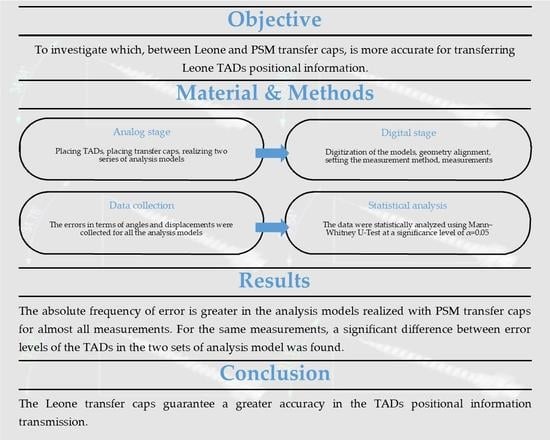Comparison of the Accuracy of Two Transfer Caps in Positional Transmission of Palatal Temporary Anchorage Devices: An In Vitro Study
Abstract
1. Introduction
2. Materials and Methods
2.1. Analog Stage
2.2. Digital stage
- Digitization of the models
- Leone scan bodies for TADs were screwed onto the emerging head of the TADs and TAD analogues.
- Each digital master model was superimposed with its respective digital analysis models using some teeth and palatine rugae as reference points (Figure 4). In this way, a single reference system for each set of models was defined.
- Geometry alignment
- From the Leone digital library, stereolithography files (STLs) of the scan body and TAD were selected and then coupled together using MAESTRO 3D software (version 5).
- A coupled scan body and TAD unit were matched with each scan body of every set of models previously embedded as single reference systems using MAESTRO 3D software (Figure 4).
- Setting the measurement method
- 4.
- Measurements
2.3. Data Collection
2.4. Statistical Analysis
3. Results
4. Discussion
Study Limitations
5. Conclusions
Author Contributions
Funding
Institutional Review Board Statement
Informed Consent Statement
Data Availability Statement
Acknowledgments
Conflicts of Interest
References
- Mejía, J.B.C.; Wakabayashi, K.; Nakamura, T.; Yatani, H. Influence of abutment tooth geometry on the accuracy of conventional and digital methods of obtaining dental impressions. J. Prosthet. Dent. 2017, 118, 392–399. [Google Scholar] [CrossRef]
- Blatz, M.B.; Conejo, J. The Current State of Chairside Digital Dentistry and Materials. Dent. Clin. N. Am. 2019, 63, 175–197. [Google Scholar] [CrossRef]
- Raghis, T.R.; Alsulaiman, T.M.A.; Mahmoud, G.; Youssef, M. Efficiency of maxillary total arch distalization using temporary anchorage devices (TADs) for treatment of Class II-malocclusions: A systematic review and meta-analysis. Int. Orthod. 2022, 20, 100666. [Google Scholar] [CrossRef]
- Pozzan, L.; Migliorati, M.; Dinelli, L.; Riatti, R.; Torelli, L.; Di Lenarda, R.; Contardo, L. Accuracy of the digital workflow for guided insertion of orthodontic palatal TADs: A step-by-step 3D analysis. Prog. Orthod. 2022, 23, 27. [Google Scholar] [CrossRef] [PubMed]
- Chang, H.; Tseng, Y. Miniscrew implant applications in contemporary orthodontics. Kaohsiung J. Med. Sci. 2014, 30, 111–115. [Google Scholar] [CrossRef] [PubMed]
- Jasoria, G.; Shamim, W.; Rathore, S.; Kalra, A.; Manchanda, M.; Jaggi, N. Miniscrew Implants as Temporary Anchorage Devices in Orthodontics: A Comprehensive Review. J. Contemp. Dent. Pract. 2013, 14, 993–999. [Google Scholar] [CrossRef]
- Magkavali-Trikka, P.; Emmanouilidis, G.; Papadopoulos, M.A. Mandibular molar uprighting using orthodontic miniscrew implants: A systematic review. Prog. Orthod. 2018, 19, 1. [Google Scholar] [CrossRef] [PubMed]
- Iodice, G.; Nanda, R.; Drago, S.; Repetto, L.; Tonoli, G.; Silvestrini-Biavati, A.; Migliorati, M. Accuracy of direct insertion of TADs in the anterior palate with respect to a 3D-assisted digital insertion virtual planning. Orthod. Craniofacial Res. 2022, 25, 192–198. [Google Scholar] [CrossRef]
- Suzuki, E.Y.; Suzuki, B. Accuracy of Miniscrew Implant Placement With a 3-Dimensional Surgical Guide. J. Oral Maxillofac. Surg. 2008, 66, 1245–1252. [Google Scholar] [CrossRef]
- Schenz, N.; Schwarz, V.; Hörmann, R.; Crismani, A.G. Impression material accuracy for palatal orthodontic miniscrews. J. Orofac. Orthop. 2020, 81, 427–439. [Google Scholar] [CrossRef]
- Ahn, H.; Kang, Y.; Jeong, H.; Park, Y. Palatal temporary skeletal anchorage devices (TSADs): What to know and how to do? Orthod. Craniofacial Res. 2021, 24 (Suppl. S1), 66–74. [Google Scholar] [CrossRef] [PubMed]
- Rajapur, A.; Dixit, S.; Hoshing, C.; Raikar, S.P. The Influence of Tray Space and Repeat Pours on the Accuracy of Monophasic Polyvinylsiloxane Impression. J. Contemp. Dent. Pract. 2012, 13, 824–829. [Google Scholar] [CrossRef]
- Möhlhenrich, S.C.; Brandt, M.; Kniha, K.; Prescher, A.; Hölzle, F.; Modabber, A.; Wolf, M.; Peters, F. Accuracy of orthodontic mini-implants placed at the anterior palate by tooth-borne or gingiva-borne guide support: A cadaveric study. Clin. Oral Investig. 2019, 23, 4425–4431. [Google Scholar] [CrossRef] [PubMed]
- Lie, A.; Jemt, T. Photogrammetric measurements of implant positions. Description of a technique to determine the fit between implants and superstructures. Clin. Oral Implant. Res. 1994, 5, 30–36. [Google Scholar] [CrossRef]
- Jemt, T.; Lie, A. Accuracy of implant-supported prostheses in the edentulous jaw. Analysis of precision of fit between cast gold-alloy frameworks and master casts by means of a three-dimensional photogrammetric technique. Clin. Oral Implant. Res. 1995, 6, 172–180. [Google Scholar] [CrossRef] [PubMed]
- Bergin, J.M.; Rubenstein, J.E.; Mancl, L.; Brudvik, J.S.; Raigrodski, A.J. An in vitro comparison of photogrammetric and conventional complete-arch implant impression techniques. J. Prosthet. Dent. 2013, 110, 243–251. [Google Scholar] [CrossRef] [PubMed]
- Okeagu, C.N.; Reed, D.S.; Sun, L.; Colontonio, M.M.; Rezayev, A.; Ghaffar, Y.A.; Kaye, R.J.; Liu, H.; Cornett, E.M.; Fox, C.J.; et al. Principles of supply chain management in the time of crisis. Best Pract. Res. Clin. Anaesthesiol. 2021, 35, 369–376. [Google Scholar] [CrossRef]
- Abrar, E.; Abduljabbar, A.S.; Naseem, M.; Panhwar, M.; Vohra, F.; Abduljabbar, T. Evaluating the Influence of COVID-19 Among Dental Practitioners After Lockdown. Inq. J. Health Care Organ. Provis. Financ. 2021, 58. [Google Scholar] [CrossRef]
- Muñoz-Pereira, M.; Haas-Junior, O.; Meirelles, L.D.S.; Machado-Fernández, A.; Guijarro-Martínez, R.; Hernández-Alfaro, F.; de Oliveira, R.; Pagnoncelli, R. Stability and surgical complications of tooth-borne and bone-borne appliances in surgical assisted rapid maxillary expansion: A systematic review. Br. J. Oral Maxillofac. Surg. 2021, 59, e29–e47. [Google Scholar] [CrossRef]
- Durham, J.N.; King, J.W.; Robinson, Q.C.; Trojan, T.M. Long-term skeletodental stability of mandibular symphyseal distraction osteogenesis: Tooth-borne vs hybrid distraction appliances. Angle Orthod. 2017, 87, 246–253. [Google Scholar] [CrossRef]
- Papaspyridakos, P.; Chen, C.-J.; Gallucci, G.O.; Doukoudakis, A.; Weber, H.-P.; Chronopoulos, V. Accuracy of Implant Impressions for Partially and Completely Edentulous Patients: A Systematic Review. Int. J. Oral Maxillofac. Implant. 2014, 29, 836–845. [Google Scholar] [CrossRef]
- Nakhaei, M.; Madani, A.S.; Moraditalab, A.; Haghi, H.R. Three-dimensional accuracy of different impression techniques for dental implants. Dent. Res. J. 2015, 12, 431–437. [Google Scholar] [CrossRef]
- Tafti, A.F.; Hatami, M.; Razavi, F.; Ebadian, B. Comparison of the accuracy of open-tray and snap-on impression techniques of implants with different angulations. Dent. Res. J. 2019, 16, 413–420. [Google Scholar] [CrossRef]
- Alikhasi, M.; Siadat, H.; Monzavi, A.; Momen-Heravi, F. Three-Dimensional Accuracy of Implant and Abutment Level Impression Techniques: Effect on Marginal Discrepancy. J. Oral Implantol. 2011, 37, 649–657. [Google Scholar] [CrossRef]
- Barone, T.R.; Cahali, M.B.; Vasconcelos, C.; Barone, J.R. A comparison of tooth-borne and bone-anchored expansion devices in SARME. Oral Maxillofac. Surg. 2020, 24, 181–187. [Google Scholar] [CrossRef]
- Lombardo, L.; Occhiuto, G.; Paoletto, E.; Maino, B.G.; Siciliani, G. Class II treatment by palatal miniscrew-system appliance: A case report. Angle Orthod. 2020, 90, 305–313. [Google Scholar] [CrossRef] [PubMed]
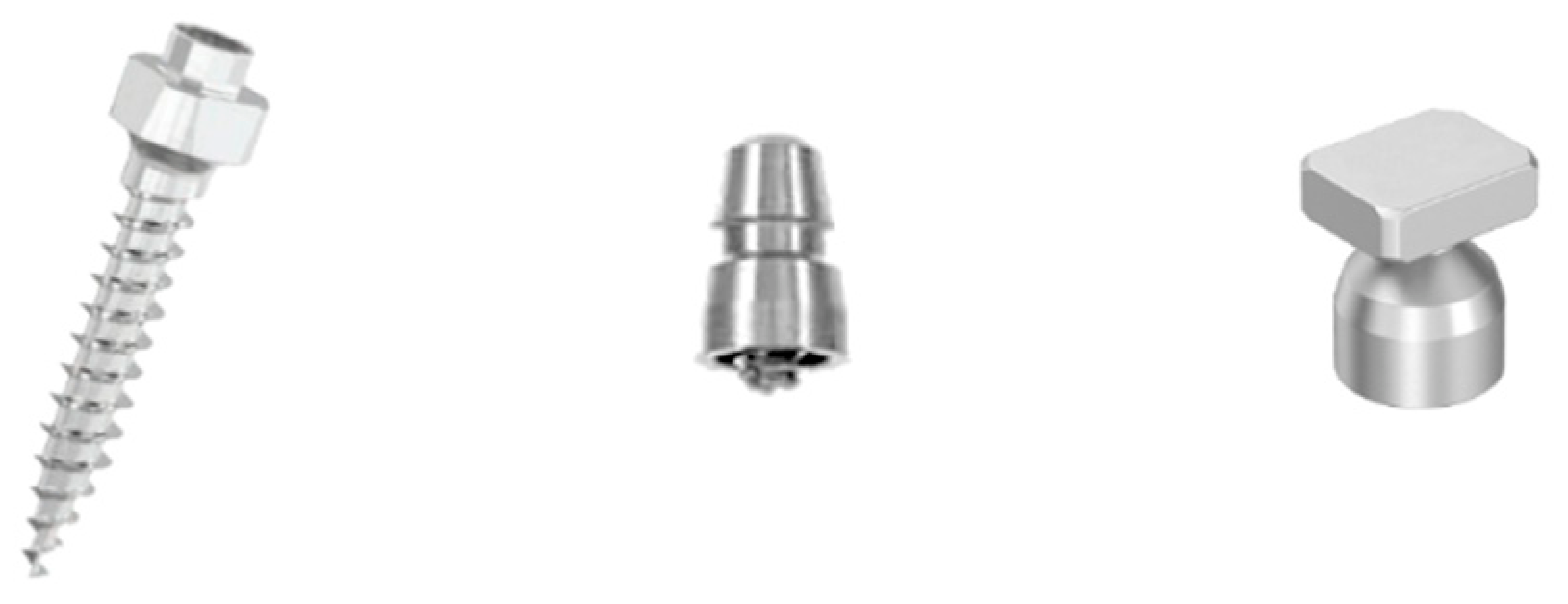
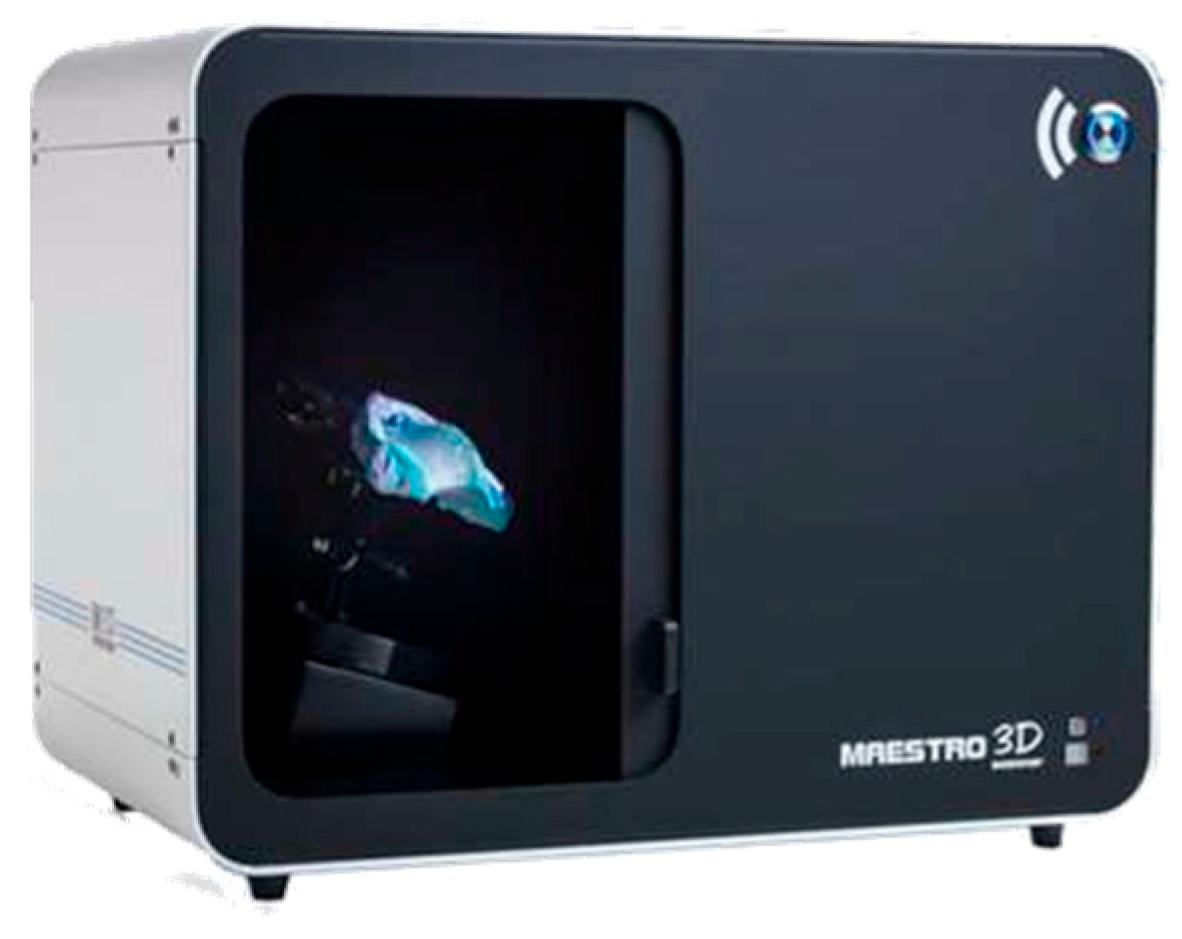




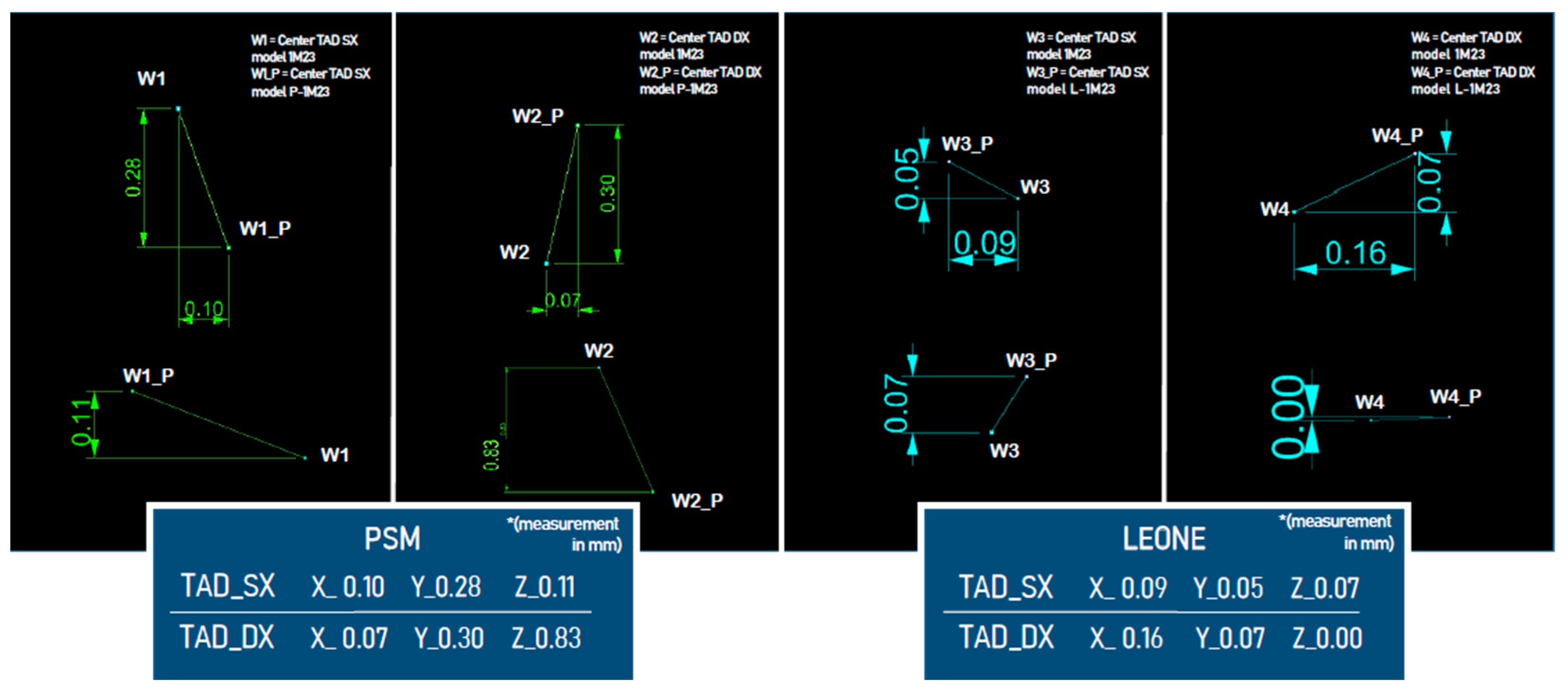
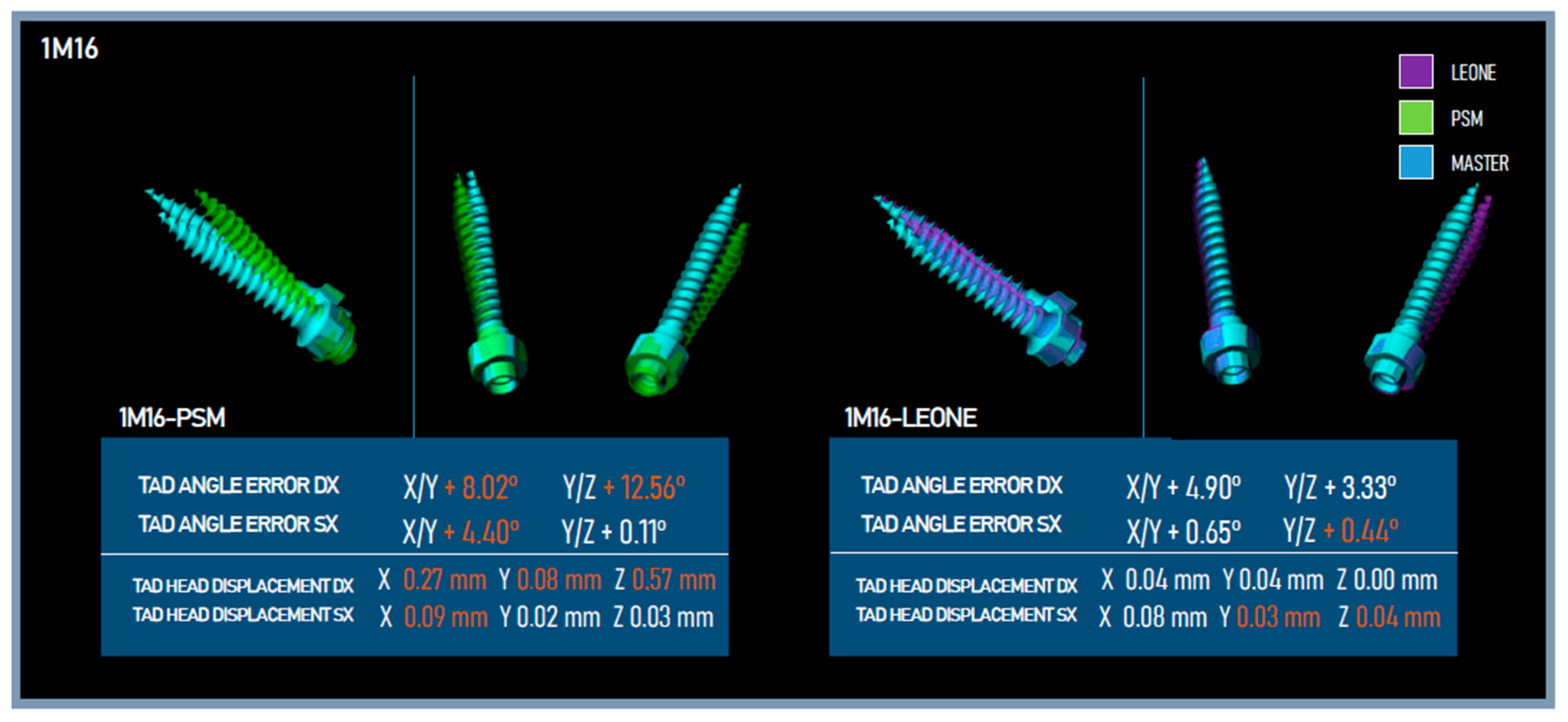

| Angle_dx xy | Angle_dx yz | Angle_sx xy | Angle_sx yz | Disp_dx x | Disp_dx y | Disp_dx z | Disp_sx x | Disp_sx y | Disp_sx z | |
|---|---|---|---|---|---|---|---|---|---|---|
| Mann–Whitney U | 602.500 | 619.000 | 669.500 | 410.000 | 730.000 | 843.500 | 807.000 | 357.000 | 623.500 | 636.000 |
| Standard Error | 67.638 | 67.638 | 67.637 | 67.639 | 67.615 | 67.611 | 66.341 | 67.516 | 67.571 | 67.580 |
|
Standardized Test Statistic | 2.255 | 2.499 | 3.245 | −0.591 | 4.141 | 5.820 | 5.381 | −1.377 | 2.568 | 2.752 |
| p | 0.024 * | 0.012 * | 0.001 * | 0.554 | <0.001 * | <0.001 * | <0.001 * | 0.168 | 0.010 * | 0.006 * |
Disclaimer/Publisher’s Note: The statements, opinions and data contained in all publications are solely those of the individual author(s) and contributor(s) and not of MDPI and/or the editor(s). MDPI and/or the editor(s) disclaim responsibility for any injury to people or property resulting from any ideas, methods, instructions or products referred to in the content. |
© 2023 by the authors. Licensee MDPI, Basel, Switzerland. This article is an open access article distributed under the terms and conditions of the Creative Commons Attribution (CC BY) license (https://creativecommons.org/licenses/by/4.0/).
Share and Cite
Quinzi, V.; Salvati, S.E.; Brutto, V.; Tasciotti, G.; Marzo, G.; Ferrazzano, G.F. Comparison of the Accuracy of Two Transfer Caps in Positional Transmission of Palatal Temporary Anchorage Devices: An In Vitro Study. Dent. J. 2023, 11, 51. https://doi.org/10.3390/dj11020051
Quinzi V, Salvati SE, Brutto V, Tasciotti G, Marzo G, Ferrazzano GF. Comparison of the Accuracy of Two Transfer Caps in Positional Transmission of Palatal Temporary Anchorage Devices: An In Vitro Study. Dentistry Journal. 2023; 11(2):51. https://doi.org/10.3390/dj11020051
Chicago/Turabian StyleQuinzi, Vincenzo, Simone Ettore Salvati, Valeria Brutto, Giorgia Tasciotti, Giuseppe Marzo, and Gianmaria Fabrizio Ferrazzano. 2023. "Comparison of the Accuracy of Two Transfer Caps in Positional Transmission of Palatal Temporary Anchorage Devices: An In Vitro Study" Dentistry Journal 11, no. 2: 51. https://doi.org/10.3390/dj11020051
APA StyleQuinzi, V., Salvati, S. E., Brutto, V., Tasciotti, G., Marzo, G., & Ferrazzano, G. F. (2023). Comparison of the Accuracy of Two Transfer Caps in Positional Transmission of Palatal Temporary Anchorage Devices: An In Vitro Study. Dentistry Journal, 11(2), 51. https://doi.org/10.3390/dj11020051






